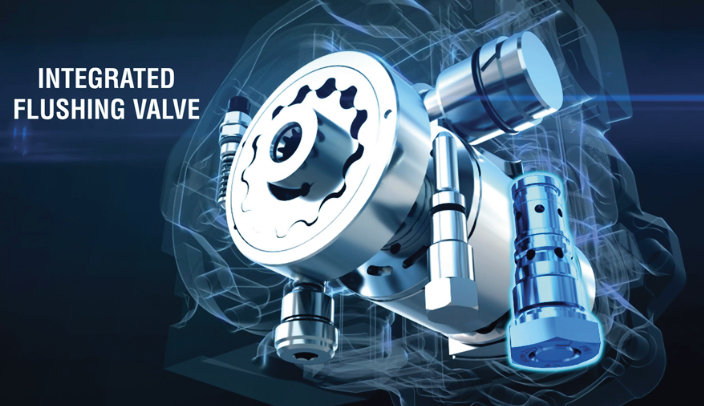Choosing a Closed Loop Axial Piston Pump
By Filippo Ganzerli, Axial Product Marketing Manager, Poclain Hydraulics

Off-highway mobile equipment requires space saving, durable, high performance components. Closed loop axial piston pumps often fit the bill.
A closed loop axial piston pump coupled with a hydraulic wheel motor comprises a hydrostatic transmission where the fluid transfers continuously from the pump to the motor and back. In an open loop system, the fluid is drawn from and returns to a reservoir by way of a directional control valve. Of these two hydraulic pump loop options, a closed loop saves valuable space by offering continuous fluid flow without the need for a large reservoir or directional valve. The pump’s reversibility is what makes these options possible in a closed loop circuit. A closed loop configuration makes the most sense for mobile machines when variations in speed, easy reverse mode, good retaining capacity, hydrostatic brake function, or traction are needed.
Design and production
Two major challenges facing machine OEMs are simplifying logistics on the production end and allowing design freedom on the engineering end. Logistically, having one supplier simplifies supply chains. Single sourcing hydraulic system components reduces the risk of incompatibility, as the parts are designed to work together. There is a similar argument for OEMs to source pumps from the same line for a range of machines for ease of maintenance and simplified training due to part commonality for the end user. Modularity, such as adding a charge pump or a flushing valve, makes system design easier. Integrating all components into a single product saves space and money with less assembly.
Control options
Choosing the correct control option for swash plate actuation is pivotal to ensuring the machine will function in the desired way. The type of controls chosen depends on the machine’s architecture and the variations in load that it will encounter. Light and simple machines work well with direct mechanical control, available, for example, on Poclain Hydraulics’ PM pumps up to 20.4 cm3/rev (1.24 in3/rev). Machines with higher performance levels may require a mechanical control with feedback, hydraulic servo control, hydraulic servo control with feedback, hydraulic automotive control, electrical on-off servo control with return spring, electro-proportional control, and electro-proportional control with feedback, all of which are available on PM10 to PM65 pumps with displacements of 7 cm3/rev to 70 cm3/rev (0.43 in3/rev to 4.27 in3/rev ).
Machine size, power requirements, end-user expectations, and environmental regulations must be considered by the OEM when selecting pump controls. Understanding the finer points of each control system is helpful for choosing the best option.
Mechanical control. With smaller machines, direct mechanical control has the lowest cost and may be the most practical option. Poclain’s mechanical control connects directly to the swash plate for changing displacement and carries the M designation. A version with a spring (codes N and L) gives an automatic return to the neutral position. Mechanical control with feedback (code A) maintains the position of the swashplate, giving the pump more stability. This is best for automatic control and provides smooth reverse, a common requirement in compactor applications.
With larger, more complex machines, electrical or hydraulic control is generally a better choice.
Hydraulic control. As pump displacement increases, the force needed to actuate the swashplate increases and the lever option becomes impractical.
Proportional hydraulic servo control (code S) is where the position of the swashplate is proportional to a pressure input signal, usually through a joystick in the cab. The power-limiting characteristic reduces engine size and allows for smooth operation. The PM10 is also available with a proportional hydraulic servo control with feedback (code T).
Electrical proportional control. Electrical control can be managed from the dashboard with direct electrical proportional control (code P). With this type of control, the swashplate is proportional to an electrical input signal. Control with feedback (code Q) assures that the swash plate position will be consistently proportional to a voltage input signal. Codes B and C indicate a control in the PM10 series where the displacement returns to zero if the voltage is lost.
Automotive control. Automotive control delivers reduced fuel consumption and noise pollution. With automotive D control, the swashplate position is relative to the pump rotation speed. It offers easy command for easy driving. For agriculture or construction machines, it offers anti-stall, with which the driver pushes or releases the pedal, as in a car. The automotive-control concept is the same from 7cc to 70 cc; Poclain is the only company in the market to propose it below 18 cc/rev.
Electronic control. Electronic control can be accomplished via an engine control unit (ECU). Some pumps, such as Poclain Hydraulics PMe pumps, come prewired and preprogrammed with ECUs, allowing for quick and easy connection to driving devices such as the travel pedal, joystick, or brake pedal.

Flanging
Flanging is another important feature to consider in determining the optimal pump for a hydraulic system. Flanging enables OEMs to incorporate additional valves into the system more efficiently. Pumps featuring a flange at the rear can provide a clean machine layout while reducing plumbing and assembly time.
In the PM pump, flange options include a flow divider or an auxiliary pump for supplementary attachments such as recycling, lifting equipment, milling tools for a telescopic application, and a bucket or fan drive actuator for backhoes or excavators.
Compact applications such as piggyback forklift trucks with space constraints between the wheels or below the cab can gain invaluable space with this flange configuration. Gear pumps from 1.6 to 26 cm3/rev» (0.10 to 1.59 cu.in/rev) can be added to the solution, either flanged or completely integrated within the PM housing. A flushing valve helps increase operational efficiency and reduce system complexity.
These features ensure system performance and allow the pump to deliver the exact power required for each application. It is integrated in the PM30 and PM50, for space savings and to reduce total cost of ownership of the machine.
High-pressure relief valves prevent system overload by limiting the maximum pressure in a system, meaning less wear on the system and lower maintenance and service costs. The relief valves maintain circuit pressure in the proper range. The check valves allow charge flow to replenish the low-pressure loop of the circuit. The high-pressure relief valves ensure protection of the circuit’s high-pressure loop.
A cut-off valve ensures that the prime mover is not overloaded. The valve acts on the servo control operating pressure to reduce the pump displacement when the combination of flow and pressure exceed the engine capacity.
From the perspective of an end user, maintenance is easier when pumps combine elements. It eliminates the need to manage several components. Also, setting, behavior, and performance of the machine are easier because all the components are part of the same hydrostatic transmission.
Sizing the correct pump is also a very important step in choosing the correct pump for a machine. First, a motor is chosen that can transmit the maximum required torque and attain the maximum rpm. Then the pump is selected that will provide the necessary flow at a pressure that will satisfy the motor.
Hydraulic unit life
Hydraulic unit life is the life expectancy of the hydraulic components. It depends on speed and system pressure, even if system pressure is the dominant operating variable. High pressure, generated by high load, reduces hydraulic unit life.
The hydraulic system that incorporates the pump needs to be designed according to the expected machine duty cycle. Take into consideration the expected percentages of time that the machine will spend at various loads and speeds.
The many different axial piston pumps on the market with their various options and features affect machine design, performance, and end-user comfort, among other variables. A starting point is to understand the options and impacts of a pump being integrated into a closed loop circuit.







